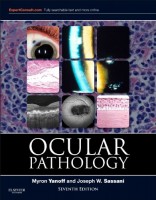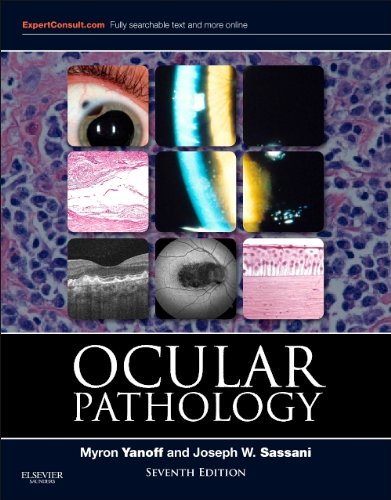 Authors: Myron Yanoff, MD; and Joseph W. Sassani, MD, MHA
Authors: Myron Yanoff, MD; and Joseph W. Sassani, MD, MHA
Publisher: Elsevier Saunders – 701 pages
Book Review by: Nano Khilnani
Ocular pathology is the study of the nature and progression of diseases of the eye, and this text provides you, the student or practitioner, the clinical understanding necessary for precise medical and surgical management.
The authors point out that ophthalmology is primarily an image-oriented specialty, and almost all of the important structures of the eye can be viewed in at least two dimensions by various examination techniques, primarily slit lamp biomicroscopy and posterior segment ophthalmoscopy. The third dimension – depth – can be viewed through light microscopy when tissue is available for examination.
But light microscopy is just one of several examination techniques in the disciple of ophthalmic pathology. In recent years, in vivo imaging, mainly in the form of ocular computed tomography (OCT) has also been useful in perceiving tissue depth in real-time viewing of ophthalmic anatomic and pathologic abnormalities.
But at the present time at least, the average resolution of in vivo imaging is much lower than that provided by light microscopy and ultra-structure viewing techniques. So you the clinician best verify what you see in those low-resolution images from the high-resolution images of histopathological and ultrastructural features of fixed tissue, the authors caution.
They further explain: “In the past, decisions made by interpretation of microscopic abnormalities of ocular tissue have been the responsibility of those few individuals with background training both in ophthalmology and surgical pathology. Now, clinicians with access to OCT will be making those interpretations themselves, often without the need for tissue biopsy and diagnosis by a subspecialist.” They expect however, that improvements in in vivo image resolution and examination techniques are expected to happen.
The range of subjects covered in this seventh edition the book, described in the Foreword by Dr J. Douglas Cameron as “the single best ophthalmic pathology reference text for ophthalmologists, pathologists, and researchers,” is extensive. This is evidenced by the titles of its 18 chapters:
- Basic Principles of Pathology
- Congenital Anomalies
- Nongranulomatous Inflammation: Uveitis, Endophthalmitis, Panophthalmitis, and Sequelae
- Granulomatous Inflammation
- Surgical and Nonsurgical Trauma
- Skin and Lacrimal Drainage System
- Conjunctiva
- Cornea and Sclera
- Uvea
- Lens
- Neural (Sensory) Retina
- Vitreous
- Optic Nerve
- Orbit
- Diabetes Mellitus
- Glaucoma
- Ocular Melanocytic Tumors
- Retinoblastoma and Pseudoglioma
Among the benefits you will derive with the use of this book are:
- Understand the role of VEGF and other factors in the pathobiology of diabetic complications, as well as the pathobiology of myocilin and the TIGR gene in the development of glaucoma
- Review the latest features related to the pathobiology of central corneal thickness
- Stay abreast of the latest in ocular pathology with coverage of the classification system for retinoblastoma; immunopathology of herpes keratitis; and genetic features of persistent hyperplastic primary vitreous
- Access the entire text online at experconsult.com, and test your visual recognition and understanding of disease with a new online image / testing feature.
Your purchase of this book entitles you to use a wealth of resources online. To get access to them, here’s what you do:
- Login or sign up at www.ExpertConsult.com
- Scratch off your PIN code found on the inside front cover of this book
- Enter your PIN into the Redeem Book Code box
- Click Redeem
- Go to My Library
The online contents of this text are accessible with your PCV, Mac, most mobile devices, and eReaders. ExpertConsult allows you to browse, search and interact with this title – online and offline.
These are the innovative features available to you online:
- Seamless, real-time integration between devices
- Straightforward navigation and search
- Notes and highlights sharing with other users through social media
- Enhanced images with annotations, labels, and hot spots for zooming on specific details*
- Live streaming video and animations*
- Self-assessment tools such as questions embedded within the text and multiple-format quizzes. *Some features vary by title
You can also get even more valuable information from another website – www.ClinicalKey.com
This search engine of Elsevier Saunders is specially designed for doctors by providing them:
- Comprehensive Content – the most current, evidence-based answers available for every medical and surgical specialty
- Trusted Answers – content supplied by Elsevier, the world’s leading provider of health and science information
- Unrivaled Speed to Answer – faster, more relevant clinical answers, so you can spend less time searching and more time caring for your patients
Seeing is learning, so this book provides numerous full-color photos of various eye diseases and disorders, as well as microscopic images of what they look like. Detailed explanations are also given in photo captions. The chapters can easily be referenced, with colored page edges. Each chapter is systematically organized with topics and subtopics. Information, including data and key points, is also provided in tables for easier absorption of material.
All in all, this is an excellent, extremely useful text on the pathology of diseases of the eye, and their medical and surgical treatment, expertly written by the authors named below.
Myron Yanoff, MD is Professor and Chairman of the Department of Ophthalmology at Drexel University College of Medicine; and Adjunct Professor of Ophthalmology at the University of Pennsylvania and Temple University in Philadelphia, Pennsylvania.
Joseph W. Sassani, MD, MHA is Professor of Ophthalmology and Pathology at Hershey Medical Center at Pennsylvania State University in Hershey, Pennsylvania.







